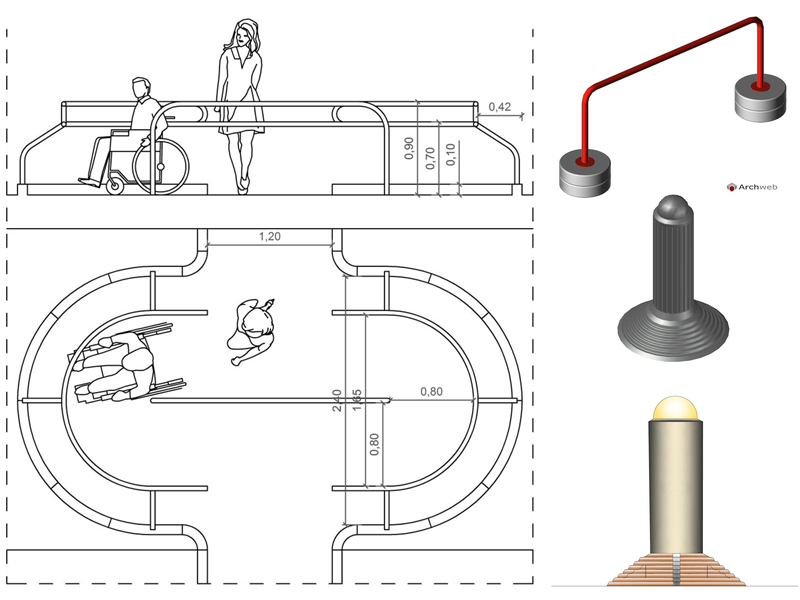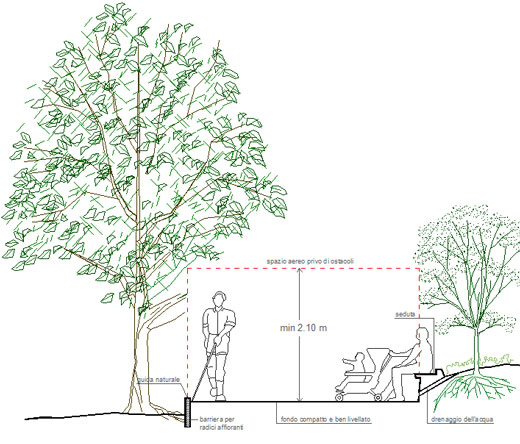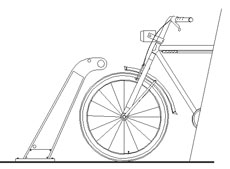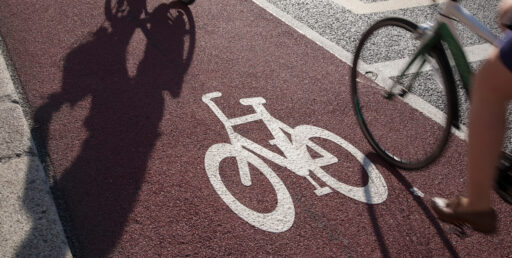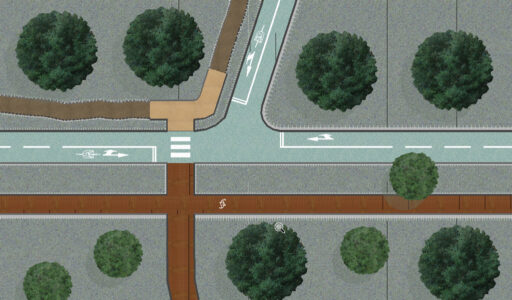Cycle paths – Guidelines
Regulation for the definition of the technical characteristics
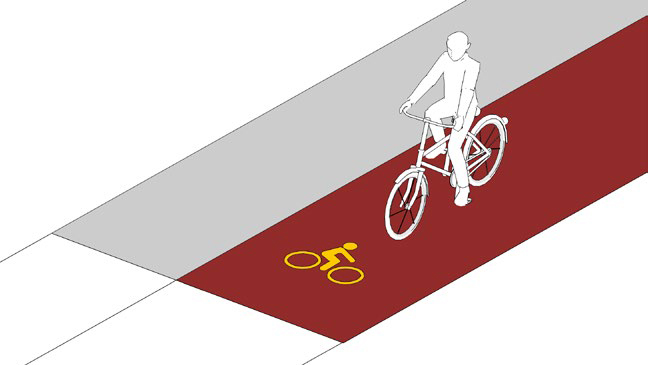
Ministerial Decree No. 557 of 30/11/1999
issued by: Ministry of Public Works
Publication of the rule on the Official Gazette n. 225 of 09/26/2000
Title / Subject
Regulation for the definition of the technical characteristics of cycle paths.
Text
THE MINISTER OF PUBLIC WORKS in concert with the MINISTER OF TRANSPORT AND NAVIGATION
Having regard to article 7 of law no. 366, “Regulations for the financing of cycling mobility”, which provides for the adoption by ministerial decree of a regulation for the definition of the technical characteristics of cycle paths;
Having regard to article 17, paragraphs 3 and 4 of the law of 23 August 1988, n. 400;
Given the legislative decree of 30 April 1992, n. 285, and subsequent amendments;
Given the decree of the President of the Republic of 16 December 1992, n. 495, and subsequent amendments;
Having heard the opinion of the Council of State, expressed by the advisory section for regulatory acts in the meeting of 11 October 1999;
Having regard to the communication to the President of the Council of Ministers, pursuant to article 17, paragraph 3, of the aforementioned law of 23 August 1988,
n. 400 (note no. 2816 of 27 October 1999);
A d o p t
the following regulation:
Chapter I
Guidelines for the design of cycle routes
Art. 1.
Premise
1. This section identifies the guidelines for the design of cycle routes and the quality elements of the different parts of the itineraries themselves. The cycle routes are identified with the road routes that can be used by cyclists, both in a reserved area (cycle path in its own seat or on a reserved lane), and in a place for mixed use with pedestrians (pedestrian and cycle path) or with motor vehicles (on roadway). These guidelines are aimed at achieving the fundamental objectives of safety and environmental sustainability of mobility: objectives that must be pursued in an organic way, evaluating each time the strategies and proposals that best respond to them.
Art. 2.
Purpose and design criteria
1. The purposes and criteria to be considered at a general planning and detailed design level in the definition of a cycle route are:
a) favor and promote a high degree of cycling and pedestrian mobility, an alternative to the use of motor vehicles in urban areas and in connections with the neighboring territory, which it is believed that the localities concerned can be reached, with pre-eminent reference to mobility work, school and tourism;
b) aim at the attractiveness, continuity and recognisability of the cycle route, favoring the shortest, most direct and safe routes according to the results of surveys on the origin and destination of cycling users;
c) evaluate the profitability of the investment with reference to real and potential users and in relation to the objective of reducing the risk of accidents and the levels of atmospheric and acoustic pollution;
d) verify the objective feasibility and real use of the cycle routes by users, according to the different age groups and different needs, for which it is necessary to verify and obtain favorable conditions, including plano-altimetric conditions paths.
Art. 3.
Planning tools
1. In order to prepare interventions consistent with the aforementioned purposes and criteria, local authorities equip themselves with the following planning and design tools:
a) a plan of the network of cycle routes, in which the interventions to be carried out are foreseen, including data on cycling flows, the length of the paths, the economic estimate of expenditure and a justified scale of priorities and implementation times. The level of preliminary and detailed investigations of the plans must be adequate to the dimensional extension of the cycle network and to the complexity of the organization model of the circulation of the other traffic components.
As part of this plan, it is possible to consider isolated itineraries that still respect the purposes and design criteria indicated in article 2. For municipalities that are required to prepare the Urban Traffic Plan (PUT), pursuant to article 36 of the legislative decree 30 April 1992, n. 285, the cycle network plan must be inserted in an organic way, as a sector plan, within the PUT, according to the indications of the ministerial directives published in the ordinary supplement n. 77 to the Official Gazette of 24 June 1995. However, for municipalities not required to prepare the PUT it is necessary
carry out a compatibility check, especially for safety purposes, with the other modes of transport;
b) the projects of cycle routes, provided for in the plan referred to in point a), which also include, where necessary, the requalification of the surrounding road space; in particular, the projects must consider and foresee adequate solutions to favor the safety of cycling mobility in the points of greatest conflict with pedestrians and motor vehicles (intersections, accesses to attractive nodes, etc..).
Art. 4.
Additional elements for your design
1. The cycle routes, located within the inhabited center or connecting with neighboring inhabited centers, may include the following types listed in descending order with respect to the safety they offer for cycling users:
a) own cycle paths;
b) cycle paths on a reserved lane;
c) mixed pedestrian and cycle paths;
d) mixed cycle and vehicular routes.
2. The cycle routes can be used for needs mainly linked to work and school mobility as an alternative transport system for the resolution – even if partial – of the major problems of urban traffic congestion or for mainly tourist and recreational needs.
3. For the planning of cycle routes, the following elements must also be kept in mind:
a) in road platform works: the regularity of cycle surfaces, preparations for level intersections and any underpasses or overpasses including their junctions, green arrangements, rainwater collection works also with any grids, provided that the latter do not cause transit difficulties for cyclists, etc .;
b) in road signs: in addition to traditional signs (vertical signs), stripes (horizontal signs) and traffic lights, indications of cycle crossings, light columns at the ends of physically impassable traffic dividers, lane markers, etc .;
c) in street lighting: special installations for night-time viewing of level crossings, which must take into account the existing trees in order to avoid shadow areas, etc .;
d) in the equipment: the racks for the parking of cycles and, especially on the tracks for tourist use, benches and shaded areas preferably trees, drinking water fountains every 5 km of the track, telephone points or alternatively indication of the most neighbors, etc.
4. Chapter II of this regulation defines the rules to be respected for the design and construction of cycle paths, while for mixed routes, whose technical characteristics are beyond the discipline of these regulations, only the indications reported in paragraphs 5 are provided. and 6.
5. The mixed pedestrian and cycle paths, identifiable with figure II 92 / b of the decree of the President of the Republic of 16 December 1992, n. 495, are usually built inside parks or areas with mainly pedestrian traffic, in the event that the width of the carriageway or the reduced amount of cycling traffic do not require the construction of specific cycle paths. The mixed pedestrian and cycle paths can also be realized, after affixing the aforementioned signs, on parts of the road outside the carriageway, raised or otherwise delimited and protected, usually intended for pedestrians, if the same parts of the road are not sufficient construction of a cycle path and a contiguous pedestrian path and the same paths become necessary to give continuity to the network of planned cycle routes. In such cases, it is considered appropriate that the part of the road to be used as a mixed pedestrian and cycle path has:
a) adequately increased width compared to the minimums set for cycle paths in article 7;
b) reduced pedestrian traffic and absence of activities attracting pedestrian traffic such as commercial routes, high density settlements, etc.
6. The cycle paths on the roadway, in mixed with motor vehicles, represent the type of itineraries at greatest risk for cycling users and therefore they are allowed to give continuity to the network of itineraries provided for by the cycle network plan , in situations where it is not possible, for economic reasons or insufficient road spaces, to create cycle paths. For the aforementioned routes it is necessary to intervene with suitable measures (interventions on the roadway, raised pedestrian crossings, establishment of the environmental islands provided for by the ministerial directives of 24 June 1995, speed retarders – in particular of the type with optical effect and with the exclusion of bumps – etc.) which in any case point to the reduction of the most dangerous element represented by the speed differential between the two traffic components, consisting of cycles and motor vehicles.
7. In order to guarantee the accessibility of the itineraries and the safety of circulation over time, the tracks and mixed routes must be constantly subject to maintenance interventions.
Art. 5.
Technical-economic feasibility
1. It is advisable, especially for financing and external contributions granted to the owner of the cycle route, that the relative project is accompanied by a technical-economic feasibility analysis. In addition to compliance with the design criteria and standards indicated in the following articles, with particular regard to the provisions of Article 6, paragraph 6, this analysis also includes the results of specific assessments of the profitability of the planned interventions.
2. In the absence of more in-depth methods of analysis, the ratio “lire invested / cyclists x km” can be assumed as an indicator of the profitability of the investment, referring to at least the first two years of the itinerary becoming operational.
3. The calculation of the “invested lire” includes all the expenses for the construction and furnishing of the tracks or paths in the project, including those relating to any road pavement remaking and adjustments to public lighting, green roads and the system of conveying rainwater in the existing sewerage network, as well as expenses related to satisfying the demand for parking for cycles. This calculation also includes the operating expenses for the planned works, equipment and furnishings, to be referred to the annual average of the first ten years of operation.
4. In the calculation of “cyclists x km” reference can be made to the total annual distance in the first two years of operation of the itinerary in question, starting from the intensity of cycling traffic foreseen for the hour and peak day in the periods work and school on the various trunks in the project. The aforementioned traffic forecast must be documented with the exposure of cycling and vehicular flows, individual and collective, already in place on the current mixed routes falling within the range of influence of the planned itinerary, in such a way as to highlight – in particular – the share of cycling traffic in progress and that envisaged as a transfer from other modes of transport.
Chapter II
Main design standards for cycle paths
Art. 6.
Definitions, typology and localization
1. Bike path: longitudinal part of the road, suitably delimited, reserved for the circulation of cycles.
2. The cycle path can be built:
a) in its own seat, with one or two-way traffic, if its seat is physically separated from that relating to motor vehicles and pedestrians, through suitable longitudinal median dividers physically impassable;
b) on a reserved lane, obtained from the roadway, with one direction of travel, in agreement with that of the contiguous lane intended for motor vehicles and normally located to the right of this lane, if the separation element is essentially constituted by longitudinal border strip or by lane delimiters;
c) on a reserved lane, obtained from the sidewalk, with one or two-way traffic, if the width allows it to be built without prejudice to the circulation of pedestrians and is located on the side adjacent to the roadway.
3. However, there may be cycle paths made up of two contiguous reserved lanes in the following cases:
a) on pedestrian streets, if the intensity of bicycle traffic in relation to pedestrian traffic requires it to be carried out; in this case they are lanes in the opposite direction, generally located in the center of the road;
b) on the roadway, if the intensity of the cycling traffic requires it; in this case they are cycle lanes in the same direction of travel always located on the right with respect to the adjacent lane intended for motor vehicles.
This solution is mandatory when conditions of particular intensity of cycling traffic exist and its flow is greater than 1,200 units / hour, for at least two peak periods of not less than fifteen minutes in the space of twenty-four hours.
4. Except in particular cases, for which it is necessary to provide specific demonstration of the technical validity of their adoption for the purposes of road safety, especially with reference to conflicts on intersection areas, the construction of two-way cycle paths is not allowed. running with lanes both located on the same side of the road platform.
5. In the urban area, cycling must be directed mainly on local roads and, where it is expected to take place with a consistent intensity on roads of the main network, it must be adequately protected through the creation of cycle paths.
6. In general and with specific reference to the type of roads indicated in the legislative decree 30 April 1992, n. 285, it should be noted that:
a) on motorways, extra-urban and urban, and on main extra-urban roads, cycling is prohibited, pursuant to article 175 of the aforementioned legislative decree, and to be directed on the relative service roads;
b) on secondary extra-urban roads and on urban circulation roads, the cycle paths – where necessary – must be built on their own, except in cases in which the relative protected paths are implemented on the sidewalks;
c) on the urban neighborhood streets and on the extra-urban local roads, the cycle paths can be built not only on their own premises, but also on reserved lanes;
d) on local urban roads, cycle paths – where necessary – must always be built on reserved lanes.
Art. 7.
Width of lanes and mediants
1. Taking into account the overall dimensions of cyclists and cycles, as well as the space for balance and a suitable lateral clearance free from obstacles, the minimum width of the cycle lane, including the margin strips, is equal to 1.50 m; this width can be reduced to 1.25 m in the case of two contiguous lanes, of the same or opposite direction of travel, for a minimum overall width of 2.50 m.
2. For own cycle paths and for those on reserved lanes, the width of the cycle lane can be exceptionally reduced up to 1.00 m, provided that this value is continued for a limited length of the cycle route and this circumstance is properly reported.
3. The widths referred to in the preceding paragraphs represent the minimum mandatory for the tracks on which the circulation of two-wheeled cycles only. For the tracks on which the circulation of cycles with three or more wheels is allowed, the above mentioned
dimensions must be suitably adequate taking into account the dimensional limits of the cycles set by article 50 of the legislative decree 30 April 1992, n. 285.
4. The width of the physically impassable traffic divider that separates the cycle path in its own seat from the carriageway intended for motor vehicles must not be less than 0.50 m.
Art. 8.
Design speed and plano-altimetric characteristics
1. The design speed, to which the stopping distances and therefore the lengths of unobstructed view in particular should be correlated, must be defined for each section of the cycle paths, taking into account that cyclists in the plains generally proceed at a speed of 20-25 km / h and downhill with a 5% gradient can reach speeds even higher than 40 km / h.
2. In the assessment of stopping distances, a variable perception and decision time must be taken into account between a minimum, equal to one second, for urban situations, and a maximum of 2.5 seconds for extra-urban situations, as well as a longitudinal adhesion coefficient to be related to the type of flooring adopted and, in any case, not higher than 0.35.
3. In the case of the creation of bicycle lanes on their own premises, independent from the roads intended for other types of road users, the longitudinal slope of the individual levels cannot generally exceed 5%, except for the ramps of the cycle crossings at levels staggered, for which a maximum gradient of up to 10% can be adopted. For the purposes of the wide usability of the cycle paths by the relative users, the average longitudinal slope of the same paths, evaluated on a kilometric basis, must not exceed 2% unless documented exceptions by the designer and provided that it is guaranteed in any case. full usability by the intended users.
4. The maximum longitudinal slope values (average and punctual) set out in paragraph 3 must also be used as a substantial reference for identifying cycle paths to be built on roads mainly intended for vehicular traffic or adjacent to them, concurrently the design criteria set out in article 6, paragraph 6.
5. The radii of horizontal curvature along the route of the cycle paths must be commensurate with the planned project speed and, in general, must be greater than 5.00 m (measured from the inner edge of the track); exceptionally, in areas of intersection and in particularly constrained points, said radii of curvature can be reduced to 3.00 m, as long as the unobstructed viewing distance is respected and the curve is suitably signaled, especially in the case and in the direction of travel. to which it is preceded by a level downhill.
6. The increase in cornering must be commensurate with the design speed and the radius of curvature adopted, taking into account both an adequate transversal adhesion coefficient and the fact that for the correct drainage of surface water a transversal slope equal to 2%, with reference to road pavements with a bituminous conglomerate wear layer.
7. Without prejudice to the limitations valid for all vehicles, including those inherent to particular zones of urban areas (for example zones with a speed limit of 30 km / h), specific speed limitations, for single sections of cycle paths, must be adopted in all those cases in which the plano-altimetric characteristics of the route can induce dangerous situations for cyclists, especially if it has proved impossible to comply with the previously indicated design criteria and standards (for bottlenecks, minimum radius curves preceded by levels downhill, etc.).
Art. 9.
Cycle crossings
1. Crossings of roadways carried out with cycle paths must be carried out with the same methods as pedestrian crossings, taking into account user behavior similar to those of pedestrians, and with the necessary adaptations required by cycling users (for example for the width of any section-breaking islands for crossings to be made in several times).
2. For level crossings, in areas of intersection for mixed use with motor vehicles and pedestrians, the cycle paths on a reserved lane must generally run alongside the internal side of the pedestrian crossings, in such a way as to establish for cyclists the roundabout circulation with one-way anticlockwise on the same intersection.
3. For crossings at staggered levels reserved for cyclists (own cycle paths) the underpass solution is generally preferred over the overpass one, ensuring that the maximum longitudinal slope of the ramps does not exceed 10% and they are built, in the case of overpasses, lateral protective barriers with a height of not less than 1.50 m.
Art. 10.
Road signs
1. Without prejudice to the application of the provisions relating to road signs provided for by legislative decree no. 285, and by the decree of the President of the Republic of 16 December 1992, n. 495, and subsequent amendments, the cycle paths must be provided with the specific vertical signs referred to in paragraphs 9 and 10 of article 122 of the aforementioned decree of the President of the Republic at the beginning and at the end of their path, after each interruption and after each intersection.
2. The cycle paths must be provided with special symbols and horizontal writings that distinguish their specialist use, even if their pavement is distinguished in color from that of the contiguous parts of the roadway intended for motor vehicles and pedestrians. Similarly, any change of direction of the runway must be indicated with special directional arrows on the pavement.
Art. 11.
Parking areas
1. Each cycle path project must be accompanied by the identification of the places and of the works and equipment necessary to meet the demand for parking for cycles and any other needs related to the development of cycling mobility, without hindering road traffic , Especially of pedestrians. The identification in question refers, in particular, both to the traffic attracting poles and to the modal interchange nodes.
2. In the new car parks located adjacent to the cycle paths, adequate surfaces must be provided to be used for parking cycles.
Art. 12.
Bicycle surfaces
1. On the cycle paths, the regularity of the surfaces must be taken care of to the utmost in order to guarantee easy transit conditions for cyclists, especially with reference to pavements made with self-locking elements.
2. The presence of water collection grids with main elements parallel to the axis of the tracks themselves, nor with transverse elements such as to cause difficulty in transit for cyclists, is not allowed on the cycle paths.
Chapter III
Transitional provisions
Art. 13.
Scope of application
1. The rules referred to in this regulation do not apply to works whose final design is approved within thirty days from the date of entry into force of this regulation.
This decree, bearing the seal of the State, will be included in the Official Collection of legislative acts of the Italian Republic. Anyone responsible is obliged to observe it and have it observed.
Rome, November 30, 1999
The Minister of Public Works
Micheli
The Minister of Transport and navigation
Treu
Seen, the Keeper of Seals: Fassino
Registered at the Court of Auditors on January 3, 2000
Register no. 1 Public works, sheet no. 1





























































